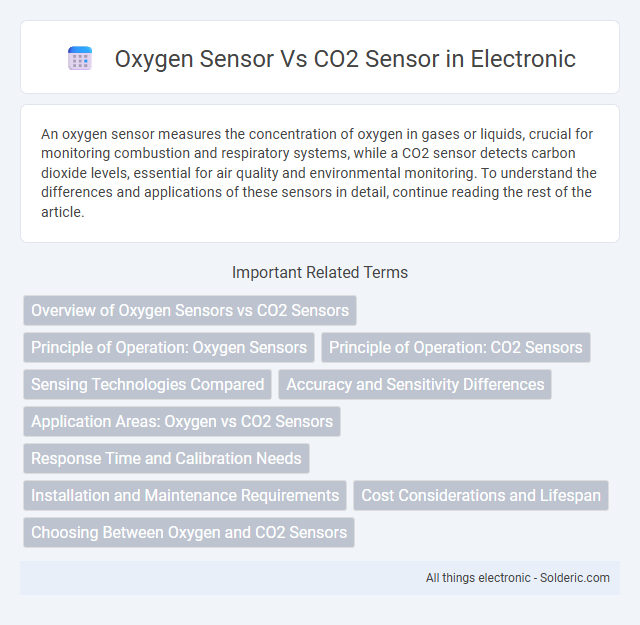An oxygen sensor measures the concentration of oxygen in gases or liquids, crucial for monitoring combustion and respiratory systems, while a CO2 sensor detects carbon dioxide levels, essential for air quality and environmental monitoring. To understand the differences and applications of these sensors in detail, continue reading the rest of the article.
Comparison Table
| Feature | Oxygen Sensor | CO2 Sensor |
|---|---|---|
| Purpose | Measures oxygen concentration in air or gas mixtures | Measures carbon dioxide concentration in air or gas mixtures |
| Common Uses | Medical devices, automotive engines, industrial processes | Indoor air quality, HVAC systems, greenhouses, safety monitoring |
| Measurement Range | 0-100% oxygen | 0-5000 ppm CO2 (typical) |
| Sensor Types | Electrochemical, Zirconia, Paramagnetic | Non-Dispersive Infrared (NDIR), Chemical, Photoacoustic |
| Response Time | Seconds to minutes | Seconds |
| Output Signal | Analog voltage/current | Analog or digital (e.g., I2C, UART) |
| Calibration | Periodic calibration with known oxygen levels | Periodic calibration with known CO2 concentrations |
| Environmental Sensitivity | Affected by temperature and humidity | Affected by temperature, humidity, and pressure |
| Cost | Moderate to high | Moderate |
Overview of Oxygen Sensors vs CO2 Sensors
Oxygen sensors measure the concentration of oxygen in gases or liquids, primarily used in automotive engines and industrial processes to optimize combustion and monitor emissions. CO2 sensors detect carbon dioxide levels in the air, commonly applied in indoor air quality monitoring and HVAC systems to ensure proper ventilation. Both sensors rely on different detection principles--electrochemical or zirconia for oxygen sensors and infrared absorption for CO2 sensors--tailored to their specific measurement targets and applications.
Principle of Operation: Oxygen Sensors
Oxygen sensors operate based on the principle of measuring the partial pressure of oxygen in exhaust gases to determine the air-fuel ratio in combustion engines. These sensors generate a voltage signal by comparing the oxygen levels in the exhaust to ambient air, allowing precise control of fuel injection for optimal combustion efficiency. Your vehicle's engine management system relies on oxygen sensor data to reduce emissions and improve fuel economy.
Principle of Operation: CO2 Sensors
CO2 sensors operate based on the principle of nondispersive infrared (NDIR) absorption, detecting the specific wavelengths of infrared light absorbed by carbon dioxide molecules. The sensor emits IR light through a gas sample, and the amount of light absorbed correlates to the CO2 concentration. This method ensures accurate, real-time monitoring of CO2 levels in various environments.
Sensing Technologies Compared
Oxygen sensors primarily use electrochemical or zirconia-based sensing technologies to measure oxygen concentration by detecting voltage changes or gas permeability, providing real-time feedback essential for combustion control and air quality monitoring. CO2 sensors often rely on non-dispersive infrared (NDIR) technology, which measures the absorption of infrared light at specific wavelengths to accurately quantify carbon dioxide levels in various environments. Your choice between oxygen and CO2 sensors depends on the specific gas detection requirements, as each technology offers distinct advantages in sensitivity, response time, and application suitability.
Accuracy and Sensitivity Differences
Oxygen sensors typically offer higher accuracy in detecting precise oxygen levels, making them ideal for applications requiring tight control of combustion or respiration processes. CO2 sensors, while highly sensitive to carbon dioxide concentration changes, may have slower response times and can be influenced by environmental factors such as humidity and temperature. Understanding the accuracy and sensitivity differences helps you choose the appropriate sensor for accurate monitoring of either oxygen or carbon dioxide in your specific setup.
Application Areas: Oxygen vs CO2 Sensors
Oxygen sensors are commonly used in medical devices, combustion control systems, and environmental monitoring to measure oxygen concentration for safety and efficiency. CO2 sensors find extensive applications in indoor air quality assessment, HVAC systems, agricultural greenhouse monitoring, and respiratory health tracking. While oxygen sensors focus on detecting oxygen levels in various gases and environments, CO2 sensors specifically monitor carbon dioxide concentration to optimize air quality and environmental conditions.
Response Time and Calibration Needs
Oxygen sensors typically have faster response times than CO2 sensors, providing almost real-time readings critical for applications like combustion control. CO2 sensors often require more frequent calibration due to sensor drift and environmental factors affecting accuracy over time. Ensuring precise measurements depends on understanding these differences in response time and calibration needs to optimize your sensor choice.
Installation and Maintenance Requirements
Oxygen sensors typically require installation in the exhaust system with careful placement near the engine to ensure accurate readings, while CO2 sensors are often installed in indoor air quality monitors or ventilation systems with less stringent positioning. Maintenance for oxygen sensors involves periodic cleaning or replacement due to exposure to high temperatures and exhaust gases, whereas CO2 sensors usually need calibration checks and filter replacements to maintain accuracy. Your choice depends on the specific application environment and the maintenance resources available.
Cost Considerations and Lifespan
Oxygen sensors generally cost less than CO2 sensors due to simpler technology and widespread use in automotive applications. The lifespan of oxygen sensors typically ranges from 30,000 to 50,000 miles or about 3 to 5 years, while CO2 sensors, used in more specialized environmental monitoring, can last between 5 to 10 years depending on the calibration and usage conditions. Maintenance and replacement costs for CO2 sensors tend to be higher because of their advanced sensing elements and calibration requirements.
Choosing Between Oxygen and CO2 Sensors
Choosing between oxygen and CO2 sensors depends on the specific application requirements, such as monitoring combustion efficiency or indoor air quality. Oxygen sensors provide accurate measurements of O2 concentration crucial for controlling combustion processes and preventing hazardous conditions. CO2 sensors are essential for assessing ventilation effectiveness and maintaining healthy indoor environments by detecting carbon dioxide levels.
oxygen sensor vs CO2 sensor Infographic

 solderic.com
solderic.com